|
There are many lines of steam vessels now sailing
from the Clyde to various parts of the world.
The total number of ships which have carried the flag
of the old Arm of G. & J. Burns, started in 1824, together with that
in the new Cunard Co., started in 1840, reaches to 180 vessels,
divided as follows:—
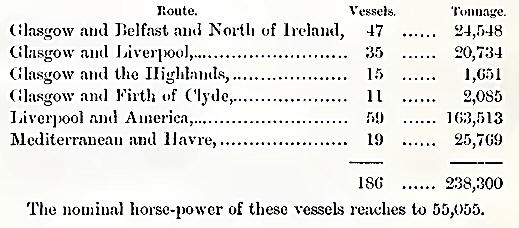
The years in which these various routes were started
are: Glasgow and Belfast, 1824; Glasgow and Liverpool, 1828; Glasgow
and the Highlands, 1832; Liverpool and America, 1840; Glasgow and
the Firth of Clyde, 1840; Liverpool and the Mediterranean, 1853.
As it is interesting to know something of the origin
of such widely-spreading and successful undertakings, so is it also
desirable to have some idea of what the first vessels were like with
which the various routes were opened. The first steamer on the
Glasgow and Belfast route belonging to Messrs. G. & J. Burns was
the Finyal, a wooden paddle steamer of 290 tons and 100 horse-power.
The powerful steamers for the Belfast service, built and
engined for the firm by Messrs Barclay, Curie, & Co.
a few years ago, measure 250 feet in length by 30 feet in breadth
and 14 feet 7 inches deep. The speed is 15 knots, the average
passage from Greenock to Belfast being 7 hours. Between Glasgow and
Liverpool there was the Glasgow, a wooden paddle steamer of 280 tons
and 100 horse-power, built by John Wood, Port-Glasgow, engined by
Caird & Co., Greenock, with side-lever engines, the steam pressure
being only 5 lbs. per square inch. Plying between Glasgow and the
Highlands was the Stuff'a, a wooden paddle steamer of 60 tons and 45
horse-power, and between Liverpool and New York, the Britannia, a
wooden paddle steamer of 1154 tons and 440 horse-power. This early
ocean steamer was only 207 feet long (about the length of an
ordinary Clyde passenger steamer of the present day), 34 feet broad,
and 22 feet deep, fitted with side-lever engines. Her speed was
about 8 J knots. Sailing between Glasgow and the coast, the Dunoon
Castle, a wooden paddle steamer of 190 tons and 50 horse-power; and
between Liverpool and the Mediterranean ports, the Taurus, an iron
screw steamer of 1126 tons and 180 horse-power (nominal).
The Britannia was built at Greenock in 1840 by R. Duncan and Co.;
the engines were by R. Napier. The dimensions were: length, 207
feet; breadth, 34 feet; depth, 22 feet; gross tonnage, 1155. There
were two side-lever engines, the diameter of the cylinders being 72
inches, with a stroke of 6 feet 10 inches. The power was 403
nominal, and the speed about 81 knots. The Persia was built in 1856
for the Cunard Co. by R. Napier & Sons at Glasgow. Dimensions:
Lengtlq 375 feet; breadth, 46 feet; tonnage, 3590; 850 nominal
horse-power, or about 3600 actual; side-lever
engines; speed, about 13 knots, and time of passage between
Liverpool and New York, 104 days; coal burned per day, 150 tons.
The Scotia, built in 1862, was the last large paddle steamer
belonging to this company.
The “Allan Line,” now possessing a large and
well-appointed fleet of Atlantic steamers, may be said to have
originated three-quarters of a century ago, when the founder of the
line, Alexander Allan, owned and commanded a ship carrying stores to
the Peninsula during the old wars. Afterwards he traded regularly
between the Clyde and Canada. In 1820 the Allan Line of sailing
ships was established, and thus formed that link between the
Scottish river and that other great river the St. Lawrence which has
been continued unbroken to the present day. In 1853 the first
steamer of this line, the Canadian, was built at Dumbarton by
Messrs. Denny, the dimensions being: length, 277 feet; breadth, 33
feet 8 inches; depth, 23 feet 9 inches; tonnage, 1765. The Canadian
mail service was begun in the same year, the vessels sailing from
Liverpool. The steam service between Glasgow, Quebec, and Montreal
was started in 1862. In 1871 the company ran vessels between
Liverpool ami St. John’s, Newfoundland, Halifax, and Baltimore.
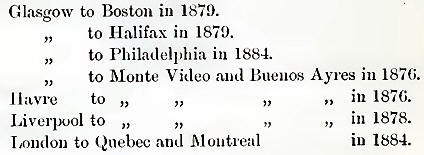
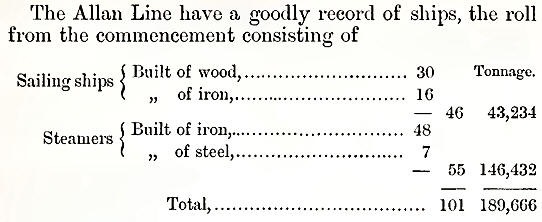
These vessels, representing as they do an investment
of about four millions sterling, will convey some idea of the
importance of this company. In the year 1881 the Parisian was added
to the fleet, built and engined by Messrs. R. Napier & Sons. This
vessel is of steel, her dimensions being: length, 440 feet; breadth,
4(3 feet; depth, 33 feet; tonnage, 536G. The first steel steamer of
this line, the Buenos Ayrean, was built in 1879 by Messrs. Denny of
Dumbarton, 4004 tons register. This vessel indeed was the first
large ocean-going steamer built of steel, which, as a comparatively
new material for shipbuilding, had still to prove its reliability
and efficiency. At the present time (1887) the Allan Line fleet
consists of

The collective nominal horse-power of the steam fleet
is about 12,530, or equivalent in these days of great pressure and
high piston speed to about 50,000 indicated horse-power.
The Anchor Line was started in 185G by Messrs.
Handyside & Henderson of Glasgow, the Mediterranean being their
first special field. In 1863, however, they commenced the Glasgow
and New York service, the Caledonia and Britannia being their first
steamers on this route; and since then their flag, with its emblem
of hope emblazoned, has waved from many a tall mast in their fleet,
their right to their adopted motto, “Secure amid perils,” having
been well-earned through the safe and efficient service which they
have now established on the ocean. The Mediterranean trade commenced
in 1854 with the Vasco de Gama, bringing from the sunny shores of
the great inland sea oranges, raisins, lemons, &c. The Atlantic
service commenced in 1857 with the Tempest, 844 tons. The Indian
service commenced in 1875 with the Cidcdonia, of 2145 tons.
Besides owning a fleet of steamers, the firm carry on
extensive ship-building and engineering works at Glasgow.
Since its commencement the company has had close on
100 vessels, having a collective tonnage of 159,000 tons.
Forty-three of these comprise the existing fleet, with a total
tonnage of 117,000 tons. Of these the Fnrnessia is the largest
vessel sailing from the Clyde, being 445 feet in length by 44 feet
beam, and 34 feet deep; tonnage, 5494 tons.
The building of sailing ships still continues to be
carried on to a large extent notwithstanding the progress of steam;
and one can frequently see some great “four master” getting fitted
with hollow iron masts, wire-rope standing rigging and running
tackle, with yards and sails, double topsails, and what not.
The sailing ship, both as a line packet ancl a China
clipper, is largely a thing of the past; but still the demand for
sailing vessels for certain routes continues. The races of the old
China clippers were exciting events, these vessels often leaving
with their cargoes of tea about the same time, and thereafter
traversing the many thousand miles of their course, only again
sighting each other as they approached the English Channel. As many
famous ships of this class were built on the Clyde, and owned by
merchants there, it may be of interest to state that the Sir
Lancelot, which was built by Messrs. Steele at Greenock, and owned
there by Mr. John MacCunn, made the passage in 18G9 from Foochow to
London in 89 days, averaging, during many days, fully 300 miles per
day.
Mr. Thomas Gray, C.B., of the Board of Trade, in an
interesting address on the maritime legislation of the last fifty
years, delivered before the members of the Shipwrights’ Company,
London, gives a number of interesting details, some of which may not
be unfitly referred to in a work on the river Clyde, more especially
as he refers to that river several times in the course of his
remarks. Speaking of the great development of the shipping interest,
he says: “In 1836 there were 25,820 ships on the register of British
ships, and their tonnage was 2,792,646 tons. Of these ships 600 were
steamers of 67,969 tons.” “In 1886 there were 38,335 ships on the
register of British ships, and their tonnage was 9,323,615 tons. Of
these ships 8913 were steamers of 4,293,115 tons. Comparing the
effective tonnage by assuming that one steam ton does four times the
work of one sailing ton, Mr. Gray concludes “that while in 1836
(taking the work done by a sailing ton as the unit) there were
2,996,553 effective tons of shipping, there were in 1886 22,202,960
tons.” In speaking of our ships, lie says: “Before 1836 British
ships were chiefly built of wood, and were chiefly sailing ships;
and naval architecture had received no adequate attention in this
country, the tonnage law being much to blame for this; but since the
tonnage law of 1854 was passed, and the improvements effected by the
skill of naval architects, and classification, the models of ships
have now been brought to much perfection.”
In speaking of seamen, Mr. Gray, says: “British
seamen are now divided into five distinct classes, and the division
between men in each of those classes is broadening and becoming
marked every day. Now the navy trains its own men, and is the most
popular branch of the national services.” Fishermen have now become
a separate class. Firemen, stokers, &c., form the third; the fourth
is the British mercantile Jack; the fifth Asiatics and others, but
British subjects. Mr. Gray does not recognize the foreign seamen as
a separate class. The naval reserve numbers
18,000 men, nearly the half of whom are fishermen.
Mr. Gray, in speaking of the improvement in our seaman, says: “ I
have to put this to his credit, that he deposits in the savings-bank
at the rate of £70,000 a year.”
THE SITUATION FIFTY YEARS AGO.
As regards 1836 I must ask you to picture to
yourselves a time of which the records are as follows, viz.:—
When British ships were classed by Lloyd’s solely on
age, or according to port of building:
When protection of British shipping existed as
against foreign ships, and when British Colonial ships were excluded
from many foreign ports, and others were admitted only on paying
a surtax de pavilion: When British ships were so faulty in design,
and as sailers so slow, that British shipowners feared free-trade,
because they knew that successful competition on equal terms with
foreign ships was impossible:
When trading harbours were so shallow that the
bottoms of ships needed to be specially constructed to take the
ground:
When, in spite of the fact that some of the officers
of the larger foreign-going ships were gentlemen of the highest
attainments and of undoubted reputation, drunkenness and
incompetency among the ordinary run of officers, as well as of
seamen, was notorious:
When charts were notoriously inefficient:
When lifeboat aud rocket apparatus were not stationed
around ou | coasts:
When the mercantile marine largely depended for a
supply of seamen on pauper apprentices:
When there was no examiuation of masters, mates, Bud
engineers: When numerous lighthouses were the property of, or leased
to, individuals for their personal benefit, and when surplus light
dues went to so-called charitable purposes, and to other purposes
unconnected with shipping:
When harbour dues, town dues, charity dues, and
passing dues were levied on ships, and were also frequently
appropriated to many purposes not solely connected with shipping:
When there were no harbours which would now be called
harbours of refuge, though a passing toll had to be paid by all
ships passing Whitby, Bridlington, Dover, or Ramsgate:
When there were scarcely any docks:
When the Clyde, Tyne, and Tees were navigable only by
small vessels even at high water, and many other ports now
flourishing scarcely existed:
When freight was the mother of wages:
When payment for salvage of life was unkuown:
When ships did not carry side-lights:
When there was no international rule of the road at
sea:
When no reports of wrecks were required to be made:
When no inquiries as to wrecks were held:
When the press-gang was in full work:
When crimps preyed, and preyed unchecked, on British
seamen: When there were no savings-banks nor seamen’s money order
system:
When there was no system for recovering the wages and
effects of deceased seamen:
When the only seamen available for augmenting the
navy in emergency consisted of undrilled men of the mercantile
marine: When there was no statutory provision as to the supply of
food or as to the accommodation of seamen:
When there were no checks to the tyranny of masters
and mates at sea; no provision for the proper execution and
enforcement of contracts between masters and seamen: no naval
courts, &c.:
When one ship was not required to stand by another
ship after collision:
When a seaman could not raise any question as to the
unseaworthiness of his ship, but could be sent to prison as a
deserter if he went ashore to complain:
When there was no international or commercial code of
signals:
It is possible that but few shipowners of the present
day, especially those who now feel inclined to complain of what they
are pleased to call “government coddling” of seamen, can bring
themselves to realize such a state of things—it is within the range
of possibility that some of them never even heard of it. Yet that
was the state of things fifty years ago, and these were the features
of the so-called “good old times” whose departure, especially as
regards seamen, they profess to deplore.
The following advertisements of some of the early
steamers are taken from a sketch of the history of the Anchor Line,
published in 1872. In connection with these early records it may be
observed that the present year has a special significance in
connection with the use of steam as a means of propulsion, as it is
just one hundred years since Patrick Miller’s experiments were made
on Dalswinton Loch. Again, it is just fifty years since the first
steam-vessel crossed from this country to America. The year 1888 is
therefore the centenary of steam propulsion, and the jubilee of
ocean navigation by steam-ships. As early, however, as 1819, a
vessel called the Savannah was built in New York. She was of 800
tons burden, ship-rigged (three masts); had one inclined
direct-acting engine; cylinder, 40 inches diameter; G-feet stroke;
20 lbs. steam; paddles of wrought iron, without paddle-boxes, and
which, it is said, could be removed and shipped on deck In about 20
minutes. She sailed from New York to Savannah on 28th March, 1819.
The following advertisement appeared in a paper of the time,
notifying her return voyage to New York:—
“PASSAGE TO NEW YORK.
“The steam-shfl Savannah, Captain Rogers, will make
one trip to New York, previous to her departure for Liverpool,
should a sufficient number of passengers offer, and will be ready to
proceed in the course of this week or commencement of the next.
Apply on board at Taylor’s Wharf, or to Scarbrough & M'Kinne.”
The following advertismcnt appeared on the 19th May,
1819, intimating her voyage to Liverpool:—
“FOR LIVERPOOL.
“The steam-ship Sar<mnah, Captain Rogers, will,
without fail, proceed for Liverpool direct, to-morrow, 20th inst.
Passengers, if any offer, can be well accommodated. Apply on board.”
Apparently the public of those days had no confidence
in this new and untried method of propulsion, as no passengers came
forward. The vessel, however, set sail for Liverpool on the 20th
May, and arrived at that port on 20th June. The engine was worked
for 18 days of the passage; pitch-pine was used instead of coal.
The Savannah then boldly set sail for St. Petersburg, and returned
to her native American shore again all safe after a successful
voyage of 50 days from St. Petersburg.
Some time after her return the machinery was taken
out, and as a sailing vessel only she traded on the American coast,
until lost in a storm on Long Island.
In 1825, The Enterprise, of 500 tons, and 120
horsepower, made the passage' to India. The Enterprise was built on
the Thames by Messrs. Gordons & Co., and launched on 22d January,
1825. She had two engines of 00 horse-power each made by Henry
Maudslay. After a long and troublesome passage round the Cape of
Good Hope, as the Suez Canal was not even thought of in those days,
she reached Madras, having had to depend on her sail power for a
considerable part of the passage.
The Sirius was built by Mr. Menzies of Leith, the
engines and boilers being made by Mr. T. Wingate of Glasgow. The
dimensions of this vessel were as follows: length, 178 feet 4
inches; beam, 25 feet 8 inches; depth, 18 feet 3 inches; register
tonnage, 412. There were two side-lever engines of 270 horse-power;
and as a notable feature in these early days, she had a
surface-condenser. The cylinders were GO inches diameter with a
G-foot stroke. The paddle-wheels were 24 feet 1 inch in diameter,
having 22 boats, each 9 feet G inches long by 2 feet G inches broad.
The Sirius left Cork for New York on 5th April, 1838, and arrived
after a passage of 181 days.
The advertisement of her return voyage reads as
follows :
“British Steam-packet Ship for London, to sail from
New York, May 1, 1838.
“The New and Powerful Steam-ship Sirius, 700 Tons
Burthen and 320 Horse-Power, Lieutenant R. Roberts, Commander,
“Is intended to sail from London, March 28th,
touching at Cork, and thence, on 2nd of April, for this port,
returning from New York to London on the 1st of May. This vessel has
superior accommodation, and is fitted with separate cabins for the
accommodation of families, to whom every possible attention will be
given. Cabin, $140, including provisions, wines, &c. Second cabin,
$80, including provisions. This superior steam-ship has been
chartered by the directors of the British and American Steam
Navigation Company, of London, to meet the pressing demands of the
public, in anticipation of the steam-ship British Queen, now
building,—is a new vessel, about six months old, and has proved
herself superior to any steam-vessel in British waters in speed and
seaworthy qualities. Further information afforded on application;
and, for freight and passage, apply to Wadsworth & Smith, 4 Jones
Lane (rear 103 Front Street), agents of the British and American
Steam Navigation Company.”
The Great Western was built by Mr. Paterson of
Bristol, and engined by Maudslay of London. She was 212 feet in
length, and had engines of 440 horse-power. This vessel left Bristol
on the 8th of April, arriving in New York after a passage of 141-
days. The Sirius arrived at New York on the morning of the 23d of
April, and the Great Western on the afternoon of the same day. The
arrival of these vessels caused great excitement in New York.
The Great Western Steamship Company afterwards added
the Great Britain. The British Queen was built at London and engined
by Robert Napier. She left Portsmouth on 12th July, 1839, and
arrived at New York after a passage of nearly 15 days.
The President, a later steamer, on her return voyage from New York
to Liverpool in 1841, was never afterwards heard of. The Royal
William was the first steamer to cross the Atlantic from Liverpool.
She was 617 tons burthen and 276 horse-power. She sailed for New
York on 5th Jnly, 1838, arriving 19 days later, and returned on the
4th August of the same year. The following announcement being made
in the New York papers:—
“British Steam-ship, lloyal William, 617 Tons.
Captain Swaiu-son, B.N., Commander.
“This fine steamer, having lately arrived, will be
dispatched again for Liverpool on Saturday, 4th August, at 4 p.m.
She is only 16 months old, and from her peculiar construction, being
divided into five sections, each water-tight, she is considered one
of the safest boats in England. Her accommodations are capacious and
well arranged for comfort. The price of passage is fixed at $140,
for which wines and stores of all kinds will be furnished. Letters
will be taken at the rate of 25 cents for the single sheet, and in
proportion for larger ones, or one dollar per ounce weight.
“For further particulars, apply to Abraham Bell
& Co.; or, Jacob Harvey, 28 Pine Street.”
A vessel also named the Royal William was built at
Three Rivers, near Quebec, in 1831. She was 160 feet long by 44 feet
broad, and 17 feet 9 inches deep, and of 363 tons register. She
crossed to Liverpool in 1833, and was afterwards sold to the Spanish
government for a war vessel, and said to be the first steam-vessel
so employed. Great changes in the forms and dimensions of
steam-vessels have taken place during the period of now fully three
quarters of a century since the Comet was launched. The annexed
diagram shows the comparative sizes of some of the leading steamers
of this period. The Great Eastern, although now nearly approached in
length Ly the Atlantic liners of the present day, is still a long
way in excess of these in tonnage room, and displacement. The
annexed diagram shows the comparative midship sections of the Great
Eastern, a 5000-ton steamer, and a river steamer.
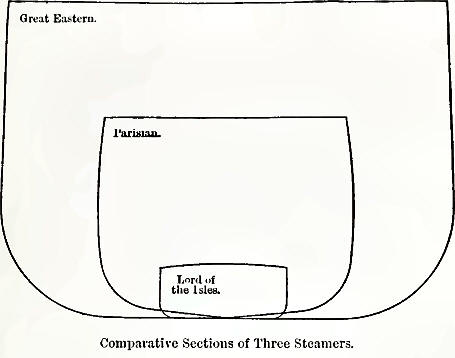
The ship-building industry of the Clyde is naturally
of older date on the lower reaches of the river, as until somewhat
recent times the Clyde from Glasgow for many miles down was too
shallow to admit of the passage of vessels of large dimensions.
It appears1 that the first square-rigged vessel, a
brig built at Greenock, was launched in 1760. In the year 1776 the
largest vessel built there was only 77 tons. There were larger
vessels, however, than this frequenting the harbour of Greenock,
some being of 250 tons. These, however, were chiefly built in the
colonies, and were owned in Glasgow. A stimulus, however, was given
to the Greenock building trade, both from the demands for larger
vessels and from the fact that the American colonial vessels,
although cheaper than those made at home, were deficient in
durability.
The introduction of steam as a propelling power, in
the beginning of the present century, gave a great stimulus to Clyde
ship-building, and by degrees the river banks have had yard after
yard added, until at the present time, from the lower part of the
Glasgow harbour, the building yards are met with on each side
extending for several miles, and thereafter at Paisley, Bowling,
Dumbarton, Port-Glasgow, and Greenock. Again, along the shores of
the Firth there are other ship-building yards, amongst which may be
noted the old yacht-building centre at Fairlie.
Several of the ship-building firms on the river have
existed under the same names or with slight variations during a long
period of years, that of Barclay, Curie, & Co. being apparently the
oldest—the business having been commenced at Stobcross in 1822.
Iron and steel has now replaced wood for the
construction of large vessels. The tonnage launched on the Clyde in
1864 was 178,505 tons, and in 1883 404,383 tons. Since this latter
date the general depression of trade has largely affected the
ship-building industry both here and elsewhere.
The following extract from Barkers Trade and Finance
Journal shows very clearly the relations of the shipbuilding trade
at home and abroad:—
“It is satisfactory to know that in ship-building the
United Kingdom continues to maintain a supremacy which is
unquestioned. We do sometimes hear of foreign competition in this as
in other branches of business, but the marvel is that we are able to
keep such an enormous lead as we do. The facts are astounding. Out
of a total of 404,016 tons registered by the United Kingdom, France,
Germany, Italy, Norway, and Sweden, during the year 1886-7, 327,743
tons were built in the United Kingdom and 76,273 tons were built
elsewhere; but out of these 76,273 tons no less than 19,916 tons
were wood or composite, leaving only 56,357 tons of iron or steel
vessels built out of, as against 327,743 built in, the United
Kingdom. Germany and France are the only countries which produce any
appreciable quantity of iron or steel tonnage, although Sweden and
Norway produce what little they require for their own use. Germany
is fast becoming a ship-building country, already producing
two-thirds of her fairly large requirements; and France produces
less than two-thirds of her requirements, although these are less
than one-third of Germany. No country in the world, excepting the
United Kingdom, is at present able to supply a market outside of
itself. Therefore, with the exception of the four countries named,
the whole world is dependent upon the ship-building yards of this
country for its fleets. We have only been able to maintain this
supremacy by keeping well to the front in all improvements. To the
enterprise and business ability of its ship-owners and ship-builders
this country owes much. There does not appear to be any likelihood
that they will lag behind in the future. One illustration will show
how they are taking the lead now. In the building of ships, as in
many other directions where iron has been largely used, the merits
of steel, as compared with iron, is one of the most important
questions of the day, and is being undoubtedly settled in favour of
steel. Figures clearly show that we are not slow to adopt
improvements, but rather that we are much more ready than the rest
of the world to do so. While we have practically leased the building
of wood and composite vessels, more than one-half of the total built
elsewhere are still of these obsolete types, and iron vessels are
nearly as two to one of steel, whereas we are building considerably
more of steel than of iron.”
Ship-building, like marine engineering, has now
become a science as well as an art, and one of the recent chairs
founded in Glasgow University is for the study of the principles on
which these important branches of our industrial activity depends.
The naval architect deals with such matters as form and stability,
and is conversant with such terms as metacentres, centres of
buoyancy, moments of stability, &c. The ship-builder, whether
working in wood, iron, or steel, has a definite series of practical
considerations before his mind both of a constructive and commercial
character from the time the keel is laid till the launching of the
vessel.
In the building yards in the old days of the “wooden
walls,”
“Covering many a rood of ground,
Lay the timber piled around;
Timber of chestnut, and elm, and oak,
And scattered here and there, with these,
The knarred and crooked cedar knees.”
Now in our great building yards it is iron and steel
frames and plates which cover the ground, and the sound of the “
busy hammers closing rivets up ” is heard on all sides.
The following are some of the leading steps in the
building of an iron or steel ship:—
1st. General design, including tonnage, speed, engine
power, draught of water, stability, &c.
2d. The keel. Logs are laid along the ground, and on
these blocks are placed at an inclination of about one in twenty
towards the water. The keel is laid along these blocks.
3d. The frames are composed of angle iron or steel.
They are bent to the required curves and riveted together, so as to
form a Z section.
4th. The beams for supporting the decks are formed
of T section, iron or steel. The frames are now put into place on
the keel, and the beams attached to them. The frames are then “
faired ” and the keelsons fitted.
5th. The plating is now put on, each plate being cut
to the proper size, and the rivet holes made. It is rolled so as to
fit the shape of the part of the vessel it is to occupy. It is then
taken to the ship, and riveting begins. The butts and edges of the
plating are then caulked water-tight by forcing the one edge close
to the other. The internal fittings arc in the meantime being
carried on.
But although it is of first importance that the
various building operations shall be successfully carried out, yet
unless suitable provision be made for getting the completed vessel
into the water the labour would be thrown away, or, as in the case
of the launching of the Great Eastern, a long period of time might
elapse and expense be incurred before this was accomplished. The
launching of a ship, especially of such vessels as are now built for
our ocean lines, is therefore a matter of great importance, and has
to be carefully considered. Generally speaking the various steps are
as follows: The vessel having been built resting on the keel-blocks,
ways are laid down on each side, and a timber structure called a
cradle formed around the under part of the vessel. The cradle rests
on the ways. The ways are inclined with slopes varying according to
circumstances.
Prior to the launch these ways arc coated with
grease, and the cradle allowed to rest upon them; the keel-blocks
are then removed, and the vessel allowed to rest completely on the
cradle, the latter being kept from sliding downwards by a movable
piece of wood called a dagger, which is knocked out of its place by
a heavy weight allowed to fall at the moment of launching by the
cutting of a cord, usually assigned to a lady visitor.
Besides the harbour and dock works at Glasgow already
referred to, there are other public and private docks on the line of
the river, sneli as at Bowling, Dumbarton, Port-Glasgow, and
Greenock.
The harbour works at Greenock are now distinguished
as the old and new works.
The West Harbour, commenced 1707, has a water area
of 7b acres, with a public graving-dock 220 ft. long, with about 10
ft. depth on sill. The East India Harbour, commenced 1805, water
area 6½ acres. A public graving-dock is connected with this harbour,
356 ft. in length, depth on sill about 12 ft. The Victoria Harbour,
commenced in 1846, water area 5½ acres, length 560 ft., width of
entrance 150 ft., depth at low water 14 ft. The Albert Harbour,
commenced 1862, water area lOf acres, length 1000 ft., width of
entrance 100 ft., depth at low water 14 ft. In the construction of
the Albert Harbour a new system of working without coffer-dams was
introduced by the engineers Messrs. Bell & Miller, C.E., of Glasgow.
The method adopted was to “form the walls under low water of a
combination of cast-iron guide-piles in the front, with a continuous
stone-facing slid down over and inclosing these, and of concrete
backing deposited in a soft state;” timber bearing piles being used
where required, the walls from the low-water line being carried up
of masonry. The ground was found to be unequal, the upper being mud
and sand, further down red “ till.” The concrete employed was formed
of Arden hydraulic lime (a useful material obtained to the south of
Glasgow), iron-mine dust, sand, gravel, and stone chips.
The new works wholly or partly completed, comprise:
The Garvel Basin, area 6 acres, width of entrance 175 ft., depth at
low water 25 ft. The Great Harbour, area 45 acres, depth at low
water 28 ft. The James Watt Wet Dock, water area 14 acres: two
entrances of 75 ft. each, depth on sills 32 ft. Garvel Graving Dock,
G35 ft. in length, width of entrance GO feet G inches, depth on sill
20 feet.
From the Annual Report of the Clyde Trustees for the
year ending June, 1887, it appears that the total imports at Glasgow
from foreign ports was 1,1 GO,598 tons; coastwise, G4S,010 tons;
whilst the exports during the same time were: to foreign ports
1,202,27G tons, and coastwise 712,174 tons.
The goods imported consist mainly of

Of goods exported coal, iron, and machinery have the
chief place. Thus—
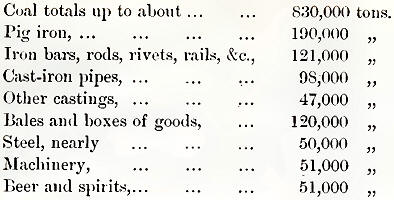
Amongst other articles exported from Glasgow were the
following:—
The annual revenue of the Clyde Trust in ten-year
periods, from 1787, is as follows:—
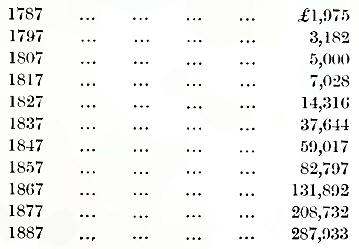
From 1752 to 1770 it was only £147, in 1771 it was
£1044, and the total revenue to 1887 is £7,107,281. This revenue was
mainly derived from dues on vessels and on goods. The annual revenue
and tonnage of the ports on the river appear to be as follows:—
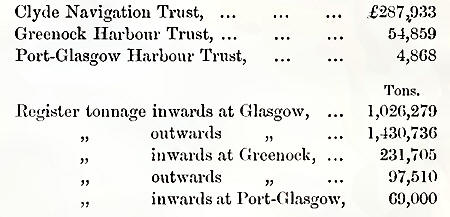
The revenue of the Clyde Lighthouse Trust appears to
be €12,070.
Measured miles2 have been laid olf at Skelmorlie and
in the Gareloch, where trials of the speeds of vessels can be made,
the time being taken as the steamer passes the extremities of the
measured distance, which are marked by two tall posts. It is also
customary to test the speed by running the lights, or taking the
time occupied on the run between the Clocli and Cumbrae Lighthouses;
this distance is 13'666 knots, or 15‘736 statute miles. Buoys for
compass adjustment are laid down in the Gareloch.
The question of the relation existing between speed
and resistance has of Bate years been ably investigated both
experimentally and mathematically, amongst others by the late Dr.
Fronde of Torquay, and by two well-known Clyde ship-builders, Mr.
Robert Mansel and the late Mr. William Denny. Dr. Froude’s
experiments were carried out in a large tank 270 feet long by 36
feet broad and 10 feet deep, containing suitable mechanism for
moving the models. These latter varied in size from 6 feet to 20
feet, and were made of paraffin.
Messrs. Denny, at their ship-building works at
Dumbarton, have constructed a large tank for the same purpose, with
special machinery for recording the results obtained, and also for
making the models.
The principal elements of ship resistance, as
determined by Dr. Froude, consisted in frictional resistance of the
skin of the ship, eddy resistance, and wave-making resistance.
Much useful information as to power and speed has
been derived from progressive speed trials, due largely to the
labours of the late Mr. Wm. Denny, and from diagrams constructed of
the results obtained. Thus, if the speeds are set off to scale on a
horizontal line, and the corresponding power required to drive the
ship sets off as verticals, the curved line joining the upper ends
of these vertical lines will show the relation between the speed and
power. Mr. Mansel, in analysing these relations, takes the
logarithms of the ratios of the different powers and speeds, and
uses these for the verticals raised at the corresponding speeds, the
result being that the relation between these verticals and the
horizontal distances is now shown by a straight line more or less
inclined.
Mr. Mansel, in treating of this subject, says: “In a
given steam-vessel under experiment, if we carefully measure various
rates of development of the power, and note for each the
corresponding rate of speed of the vessel, the normal law of the
relation of these elements, power and speed, can be stated thus:—The
logarithms of the ratio of the power to the speed, drawn as
ordinates to the speed laid off* as abscissa3s, will range in a
straight line inclined to the axis.”
In a paper read before the Greenock Philosophical
Society in 1882, on “The Speed and Carrying of Screw Steamers,” the
late Mr. Win. Denny explains in a very lucid manner the law of
comparison between the ship and model. He says: “What Mr. Froude
discovered amounts to this—that for vessels of the same
proportionate dimensions, and of the same form, or, as we say, of
the same lines, there are speeds appropriate to these vessels which
vary as the square root of the ratio of their dimensions, and that
at these appropriate speeds the resistance will vary as the cubes of
these dimensions.” He then goes on to illustrate this, and takes the
case of two steamers, the linear dimensions of one of which are
four times greater than the linear dimensions of the
other. Thus if the length of the first is taken as 400 feet the
length of the other is taken at 100 feet, the breadth of the first
being 40 feet that of the second is 10 feet, and if the draft of
water of the first steamer is fixed at 20 feet the second will be 5
feet; the appropriate speed for these vessels will therefore be that
is, the speed of the larger vessel should be twice the speed of the
small vessel. And so Mr. Denny says: “What Mr. Froude would have
predicted of these two steamers is—that if the speed of the smaller
steamer were 10 knots, then the similar appropriate speed of the
larger steamer would be 20 knots.” At these speeds Mr. Froude proved
that the resistance, with some allowance, would be as the cube of
the steamer’s dimensions, which would give for comparative
resistance with these figures, as

This, as Mr. Denny points out, “means practically
that the resistance would vary as the displacement of the two
steamers;” so that, in the case illustrated, the speed is doubled
without adding to the resistance per ton of weight, and that
consequently at a lower speed the large steamer would have a very
much less comparative resistance; hence, “in the same type of
steamer, by simply increasing all the dimensions proportionately,
the same speed can be obtained with much less resistance per ton of
weight driven through the water—that is, since the speed remains
unchanged, much less expenditure of horse-power, and consequently
much less expenditure of coal per ton of weight driven.” |

